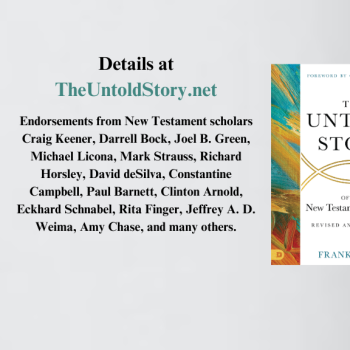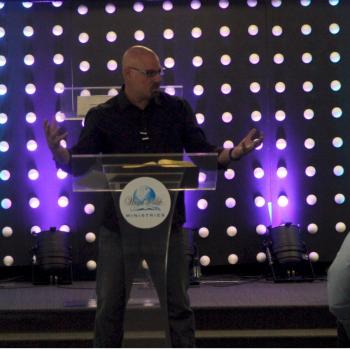First-rate New Testament scholar Jeffrey Weima has written an intriguing book on the book of Revelation. It’s called The Sermons to the Seven Churches of Revelation
I caught up with Jeffrey recently to discuss his book.
Enjoy!
There are countless books on the book of Revelation, including the seven “letters” (which you call homilies) in the beginning. Why did you write this one?
I regularly exhort my students to “surround yourself with a good cloud of witnesses.” In other words, there are lots of sources (“witnesses”) available to them both in print and on the internet but far too many of these sources are not very accurate and true, and so they need to make sure that they find and listen to “good” sources.
There are indeed many books and websites devoted to explaining the book of Revelation but many of them advocate interpretations that are unfortunately not true to the original meaning of the text and the intention of the author, and thus not helpful. I have over 30 years of experience in publishing academic articles and book-length commentaries primarily on the letters of Paul.
And despite a full-time job as a professor at Calvin Theological Seminary, I have also been involved in preaching some 50-60 times a year on average for the past four decades. So I thought that I would be in a good position with both scholarly and ministry experience to bridge the gap that often exits between the academy and pew by offering a careful study of the seven letters (better “sermons”) of Revelation 2-3.
How is your book unique from the other books on Revelation?
My Sermons to the Seven Churches of Revelation book is unique in at least two ways.
The first is in its interpretation of these seven sermons of Revelation 2-3. In addition to my teaching and preaching ministry, I also have been leading biblical study tours for over twenty years to Greece, Turkey, Israel & Jordan, and Italy.
My study tours to Turkey caused me to look more carefully at the sermons to the seven churches of Revelation which are located on the western coast of that country and which we visit on that biblical tour.
The knowledge of the archaeology, geography and social world of the first century in Asia Minor is an important, if not, crucial aspect to interpreting properly the sermons to the seven churches. This knowledge provides an important foundation for testing and evaluating the often fanciful interpretations that are often forwarded by preachers and some commentators.
My book thus offers compelling evidence for discerning the correct meaning of the striking but often confusing images found in these chapters of Revelation.
The second unique aspect of my book deals with applying these seven sermons to the church today by including at the end of each chapter my own contemporary sermon on these passages.
The first 2/3 of each chapter deals with exegesis—explaining the “then and there” of each letter/sermon–and the final 1/3 of each chapter focuses on the “here and now” by means of my own sample sermon on the text. In this way the book models the common move made by preachers and teachers who begin their study of God’s word in the office and then end their study in the pulpit or classroom.
I’m aware of the scholarship on this, but do you personally believe that John, the apostle and son of Zebedee, wrote Revelation? If so, why do you believe this? If not, who do you think wrote it?
The traditional view of the church and of Christian scholarship is that the “John” who was on the island of Patmos and who received the revelation recorded in the final book of the Bible is John, the beloved disciple of Jesus.
I share the traditional view: John is the beloved disciple of Jesus.
The opening chapter of my book includes an important section on John, how he ended up on the island of Patmos (evangelism, persecution, or something else?) and the circumstances in which he lived on that island.
There is compelling archaeological and literary evidence that John was neither alone on a deserted island nor that he was part of a chain gang doing menial labor but rather he was exiled to a small island in Aegean which contained a modest sized community.
Regarding the dating of Revelation, man y favor a later date (A.D. 90s). Other scholars, however, argue for an earlier date (on or before A.D. 70). Examples: John A.T. Robinson and more recently Jonathan Bernier. Where do you personally stand on this issue and what are the main reasons?
The traditional date assigned to the book of Revelation is around A.D. 95 near the end of the reign of the Roman emperor Domitian, and I currently hold this view. Yet there is evidence, as you indicate, to consider an earlier date.
The good news is that the interpretative issues faced in the sermons to the seven churches of Revelation 2-3 are not significantly impacted by the dating of the book.
Expound on the idea that the seven messages from Jesus in Revelation 2 and 3 are not letters, but sermons.
It is important to note that nowhere in Revelation 2 and 3 are the seven sermons described as a “letter,” so there is nothing heretical about questioning the best name or title to give to the genre of these seven messages.
Furthermore, it is also important to note that there is virtually nothing in these so-called letters that are epistolary in nature: they don’t contain any of the literary conventions that are typically found in letters of that day or of the New Testament.
In keeping with the book of Revelation’s indebtedness to the Old Testament, these seven messages are better viewed as prophetic oracles. A more user-friendly title for a prophetic oracle is a “sermon”—a Spirit inspired message to a specific audience and situation.
But while these seven messages are not formally speaking “letters,” they do exhibit a very fixed structure, and knowing this structure is important for interpreting them properly.
Each of these sermons typically follows this outline: the Christ-title (description of Jesus who is about to speak), the Commendation (Jesus begins by praising the readers for what they are doing right), the Complaint (Jesus brings a specific charge against them for what they are doing wrong), the Correction (how they can fix the situation), and the Consequence—first a negative consequence (the punishment they will receive for not repenting and correcting their sinful conduct) and second a positive consequence (the reward they will receive for repenting and changing their conduct to that which is pleasing to Jesus). Any change in this structure is significant.
So, for example, Jesus has no commendation for the seventh and final church, Laodicea, because they ought to be judged as the worst of the seven churches. This is confirmed by both the vivid language used in the content of the complaint (Jesus is about to vomit—not “spit” as most translations soften it—them out of his mouth) as well as the length of the complaint compared to the other sermons.
Give us an example of how you help readers “decode” Revelation 2 and 3.
In the first sermon to the church of Ephesus, the opening Christ-title describes Jesus as holding “the seven stars.” This image is intended to serve as a polemic against Rome and its claim to power.
The image of seven stars was regularly included on coins so as to suggest that the Romans were in charge not just of things on earth but even in the heavens. One coin, for example, has the head of the emperor Trajan on one side and the image of a crescent mood and seven stars on the other side. This coin is intended to imply that Trajan was all powerful not just on earth but also in the heavens where he controlled the moon and the seven stars.
Another coin issued by Domitian (the likely emperor when the book of Romans was written) was meant to honor his 10-year old son who died and then was declared by the emperor to be a god and worthy of veneration and worship. On the one side of the coin was Domitia, the wife of the emperor and mother of the boy.
On the other side of the coin was the image of the boy as naked (only gods and goddesses were naked in the art of that day and so nakedness was a sign of divinity) and seated on a globe in a position of power, and in his outstretched arms are seven stars.
So when the first sermon to Ephesus opens with the image instead of Jesus who holds the seven stars, this is a clear argument against Rome and its claim to universal power. By contrast, Jesus now is claiming to be more powerful than any of the Roman emperors and the Roman state.
This is only one brief example of how the knowledge of the culture, history and geography of the ancient Roman world sheds light on how the sermons to the seven churches of Revelation would have been understood by first-century Christians.
Share a big “aha” moment that you discovered while researching for the book.
Prior to researching the text of Revelation 2-3, I assumed that the seven letters/sermons were written to “super-Christians”—followers of Jesus who were suffering for their faith even to the point of death—and that the messages were intended to encourage these persecuted Christians to hang in there because one day Jesus would return, punish their enemies and vindicate their faith.
This widespread but mistaken view of the readers’ situation makes it too easy for contemporary Christians to ignore the book of Revelation because our current situation does not similarly involve this kind of persecution, and consequently Christ’s message to the seven churches does not seem relevant to our day and situation.
After digging deeper into these seven messages, however, I realized that they are written to spiritually weak Christians—followers of Jesus who were more in danger of compromising with the world than of dying to it.
Christ warns five churches against a variety of problems such as their failure to love fellow believers, idolatry, sexual immorality, false teaching, and complacency—all problems with which the affluent Western church struggles today.
Although the central problem for the remaining two healthy churches is persecution, which is not a primary concern for the Western church, opposition to the Christian faith is increasingly an issue for many contemporary churches around the globe. All of this makes the sermons to the seven churches extremely relevant to our times and important texts on which to preach and teach.

















